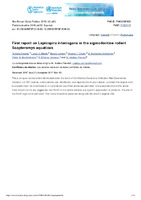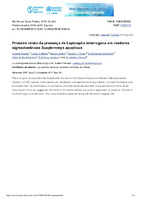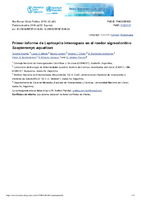Please use this identifier to cite or link to this item:
http://sgc.anlis.gob.ar/handle/123456789/1374| Title: | Primer informe de Leptospira interrogans en el roedor sigmodontino Scapteromys aquaticus | Other Titles: | First report on Leptospira interrogans in the sigmodontine rodent Scapteromys aquaticus Primeiro relato da presença de Leptospira interrogans em roedores sigmodontíneos Scapteromys aquaticus |
Authors: | Ricardo, Tamara Monje, Lucas D Landolt, Noelia Chiani, Yosena Schmeling, María Fernanda Beldoménico, Pablo M. Vanasco, Bibiana N. Previtali, M Andrea |
Keywords: | Argentina;Leptospira interrogans;Leptospirosis;Reservorios de Enfermedades;Enfermedades Transmitidas por el Agua;Zoonosis | Issue Date: | 2018 | Journal: | Revista panamericana de salud publica = Pan American journal of public health | Abstract: | Leptospirosis is a globally distributed zoonosis that can be transmitted through direct or indirect contact with the urine or tissues of infected animals. In Argentina, leptospirosis is endemic in the province of Santa Fe and epidemic outbreaks occur during floods. However, very little is known about the role that wild rodents play in the spread of the disease in Argentina. The objective of this study was to identify the host species of pathogenic Leptospira among rodents in a riverine settlement in the province of Santa Fe.We conducted a trapping session in October 2015. Kidneys of the captured animals were analyzed by real-time PCR for the LipL32 gene of pathogenic Leptospira. Animals that were positive were subjected to microscopic agglutination test (MAT) and molecular typing by amplification of the 16S rRNA gene and two multilocus sequence typing (MLST) schemes.A total of 37 rodents of the species Akodon azarae, Cavia aperea, Oligoryzomys flavescens, Rattus rattus, and Scapteromys aquaticus were captured. Real-time PCR found one male Scapteromys aquaticus that was positive. The serum of this individual and of the rest of the S. aquaticus captured (n = 18) were analyzed by MAT and were non-reactive for the 10 serovars tested. Amplification of the 16S rRNA gene identified the infective species as Leptospira interrogans, while amplification could not be obtained for the two MLST schemes.The findings of this study contribute new information concerning the presence of pathogenic Leptospira in wild rodents, which is relevant in this region because the species is widely distributed in swampy and flood-prone environments of South America. |
URI: | http://sgc.anlis.gob.ar/handle/123456789/1374 | DOI: | 10.26633/RPSP.2018.83 |
| Appears in Collections: | Publicaciones INER |
Files in This Item:
| File | Description | Size | Format | |
|---|---|---|---|---|
| 1-informe de Leptospira-Ingles.pdf | Informe en Inglés | 454.37 kB | Adobe PDF |  View/Open |
| 1-informe de Leptospira-Portugues.pdf | Informes en Portugues | 454.5 kB | Adobe PDF |  View/Open |
| 1-informe de Leptospira-Espanol.pdf | Informes en Español | 477.03 kB | Adobe PDF |  View/Open |
Page view(s)
137
checked on Dec 17, 2025
Download(s)
65
checked on Dec 17, 2025
Google ScholarTM
Check
Altmetric
Altmetric
Items in DSpace are protected by copyright, with all rights reserved, unless otherwise indicated.

